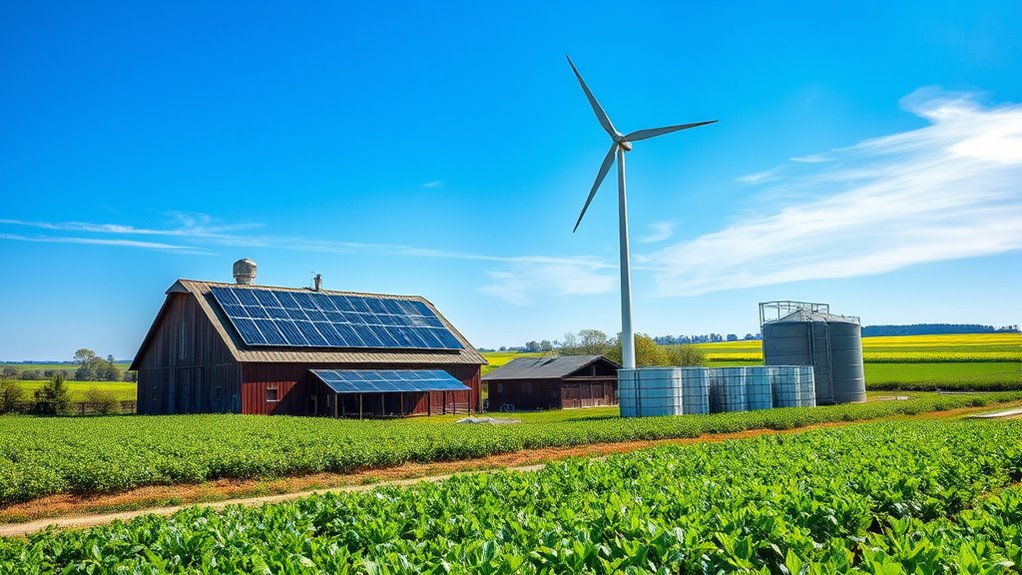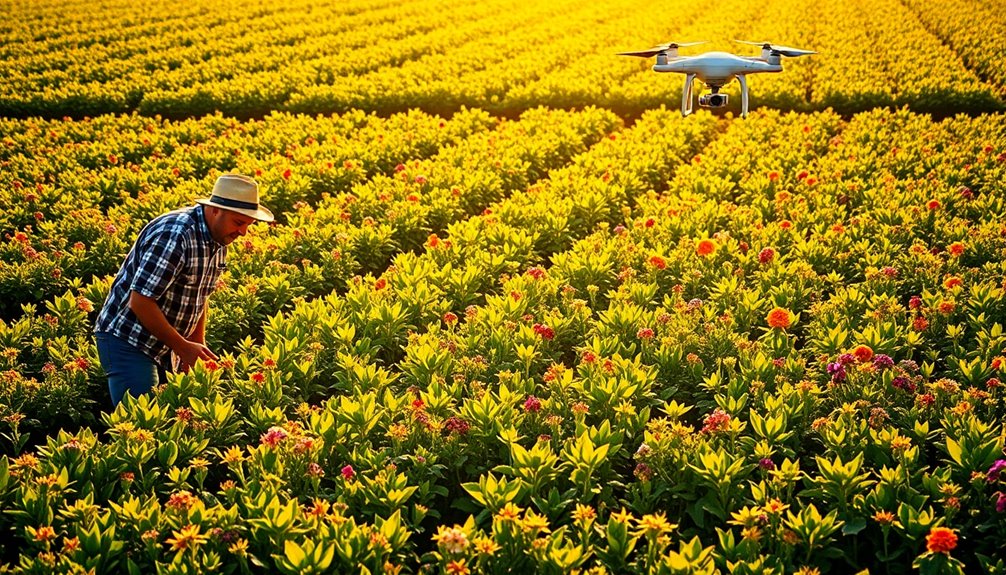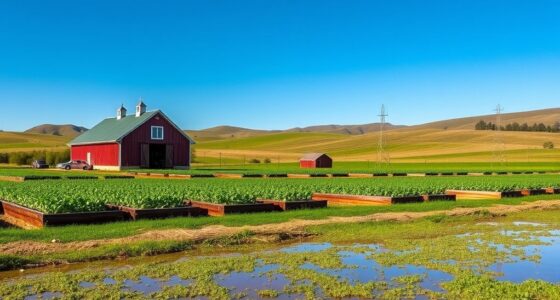You can explore several off-grid renewable energy options for your farm, including solar panels, which cut electricity costs and lower emissions. Wind turbines generate steady income while utilizing minimal land space. Don't overlook biomass for converting residues into energy. Micro-hydro systems can provide power with minimal environmental impact. Lastly, geothermal energy aids in heating greenhouses efficiently. Each option boosts sustainability and self-sufficiency, and there's more innovative technology out there to discover.
Key Takeaways
- Solar energy systems can provide electricity without emissions, helping farms become self-sufficient and reduce operational costs.
- Wind turbines can be strategically placed on underutilized land, generating income while maintaining agricultural activities.
- Micro-hydro systems harness flowing water to generate power, ideal for off-grid locations with minimal environmental impact.
- Biomass energy utilizes agricultural residues to produce renewable energy, enhancing sustainability and soil health.
- Geothermal energy can heat greenhouses and improve crop yields, offering significant cost savings for off-grid farms.
Understanding Solar Energy for Farms

When you consider solar energy for your farm, it's essential to understand how it can transform your operations and contribute to sustainability.
Solar energy systems generate electricity without emitting greenhouse gases, helping reduce climate change impacts. By avoiding harmful pollutants, you'll preserve air and water quality on your land. Additionally, incorporating energy-efficient heat pumps can further optimize your farm's energy consumption and enhance sustainability. Regular maintenance of these heat pump systems can significantly improve their efficiency and longevity, further supporting your sustainable practices.
Solar energy systems produce clean electricity, reducing greenhouse gas emissions and protecting the quality of air and water on your farm.
Solar power can enhance your farm's resilience to climate-related challenges, providing a reliable energy source that supports your operations. Plus, integrating solar can lead to significant cost savings, lowering electricity bills and operational expenses.
You might even create additional revenue streams by selling excess solar energy back to the grid. All these benefits make solar energy a smart investment for your farming future. Additionally, understanding economic indicators can help you assess the long-term viability of your solar investment.
Harnessing Wind Energy in Agricultural Settings
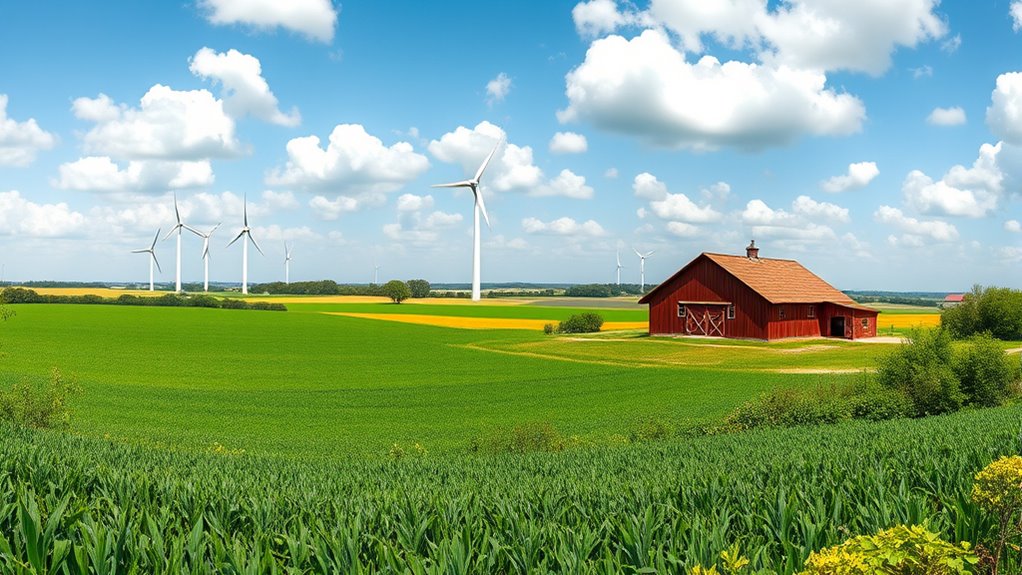
Harnessing wind energy on your farm can significantly enhance both sustainability and profitability. By installing wind turbines, you can generate a steady income through lease payments, especially during challenging years for crops or livestock.
Wind energy is clean, reducing your reliance on fossil fuels and promoting a more sustainable power system. Plus, these turbines occupy minimal land space, allowing you to maintain your farming operations seamlessly. They also require little water, making them valuable during droughts.
By strategically placing turbines on underutilized land, you can maximize energy production without disrupting your activities. Partnering with energy operators further enhances benefits, as technological advancements ensure that modern turbines are efficient and wildlife-friendly.
Embracing wind energy can lead to substantial rewards for you and your community.
Biomass Energy: Utilizing Farm Residues
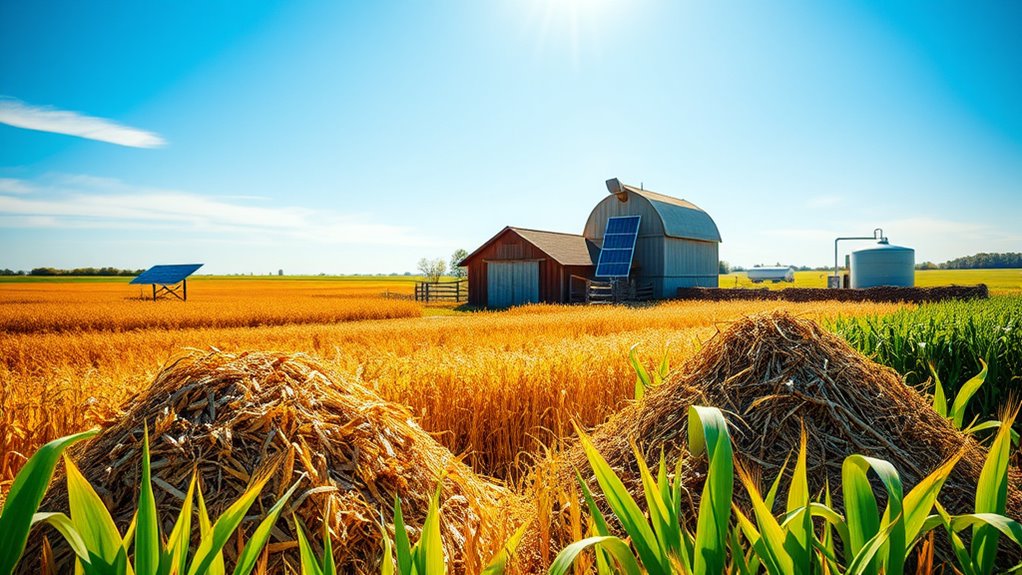
Biomass energy offers a practical solution for farmers looking to turn agricultural residues into valuable resources. By utilizing materials like corn stover, wheat straw, and manure, you can create renewable energy that reduces your reliance on fossil fuels.
With over 500 million tons of crop residues generated annually in the U.S., the potential for bioenergy production is significant. You can convert these residues into biofuels like ethanol and biodiesel, or use them for heating and electricity. Additionally, understanding filial responsibility laws can help you navigate financial planning when considering the costs associated with implementing renewable energy solutions on your farm.
Just remember, sustainable management is key to preventing soil erosion and maintaining soil health. Tools like RUSLE and WEQ can help you determine safe removal rates, ensuring that you're making the most of your agricultural residues while protecting the environment. Additionally, proper management of biomass materials can enhance soil health and support diverse farming practices.
Exploring Micro-Hydro Systems for Power Generation

Turning agricultural residues into energy is just one way to achieve sustainability on your farm.
Micro-hydro systems harness flowing water to generate power, making them ideal for off-grid locations like yours. These systems can produce up to 100 kW of electricity, significantly lowering your energy costs. With minimal environmental disruption compared to large dams, they offer a renewable energy source that ensures energy independence.
Key components include an intake structure to filter debris, pipelines for water transport, and a turbine that converts flow into electricity.
While initial setup costs can be high, the long-term savings and potential economic incentives make micro-hydro systems a worthy investment. Just be sure to consult with an installer to optimize your design.
The Role of Geothermal Energy in Sustainable Farming
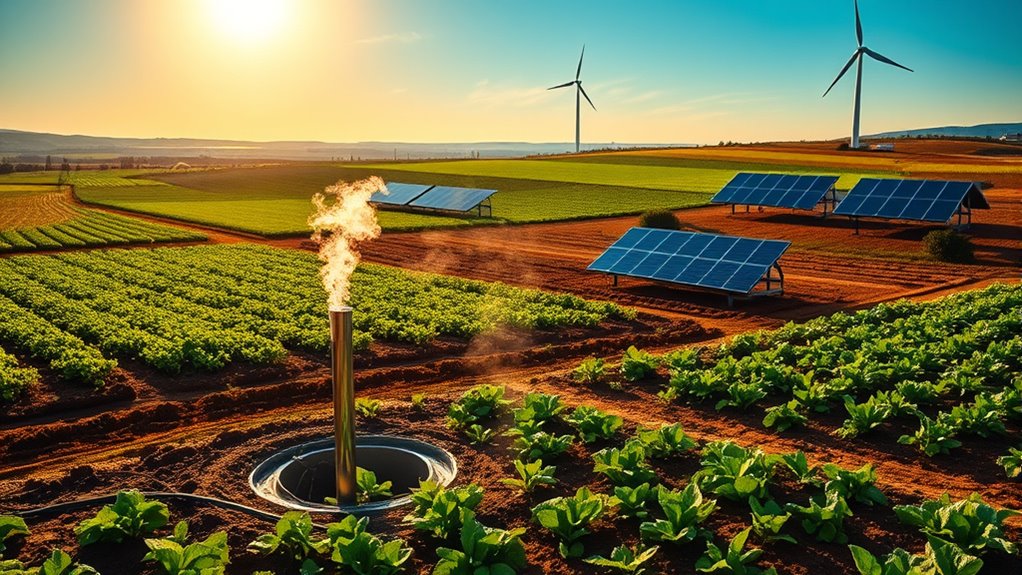
As you seek sustainable solutions for your farm, geothermal energy presents a powerful option by utilizing the Earth's natural heat. This abundant resource can significantly enhance your farming practices.
You can use geothermal energy to heat greenhouses, enabling year-round crop production and improving quality. It also aids in soil sterilization, controlling pests and diseases effectively.
Additionally, geothermal energy supports aquaculture by maintaining optimal water temperatures for fish farming. By powering your irrigation systems and drying crops, you'll minimize post-harvest losses and improve efficiency.
Geothermal energy enhances aquaculture and irrigation, reducing losses and boosting efficiency for sustainable farming.
With potential cost savings of up to 80% on heating, geothermal energy not only boosts your crop yield but also positions your farm for long-term viability in a competitive market.
Benefits of Energy Independence for Remote Farms
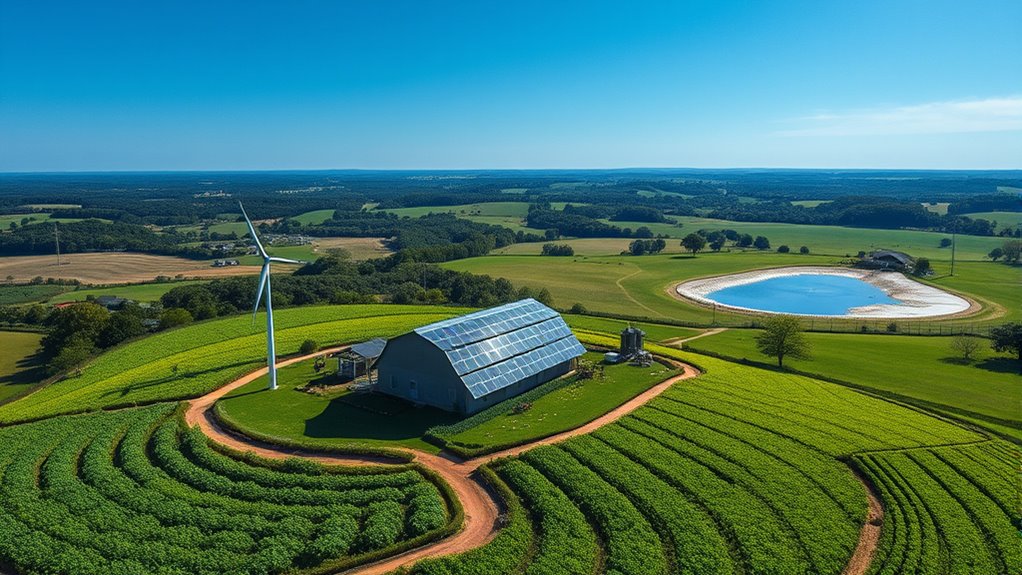
While many farms depend on external energy sources, achieving energy independence can transform your operations, especially if you're in a remote area.
By generating your own power, you reduce reliance on external suppliers, ensuring a stable energy supply that minimizes disruptions from outages. This approach can lead to significant cost savings, as you won't have to purchase electricity from the grid.
Plus, renewable systems offer enhanced reliability, allowing your farm to operate continuously. Environmentally, using renewable energy reduces greenhouse gas emissions, showcasing your commitment to sustainability.
In short, energy independence not only boosts your operational efficiency but also enhances your farm's reputation as an environmentally responsible entity.
Economic Opportunities Through Renewable Energy Projects

Achieving energy independence not only boosts your farm's efficiency but also opens up a range of economic opportunities through renewable energy projects.
By leasing land for wind or solar installations, you can generate significant income—up to $7,000 annually per landowner. These projects might contribute as much as 6% to your farm's gross cash income, reducing financial risks and helping you plan for long-term investments.
Government incentives like the Inflation Reduction Act and the Rural Energy for America Program offer grants and loans, covering up to 75% of project costs.
With job creation and increased productivity, integrating renewable energy can stimulate local economies while ensuring a sustainable future for your farm.
Technological Advancements in Off-Grid Energy Solutions
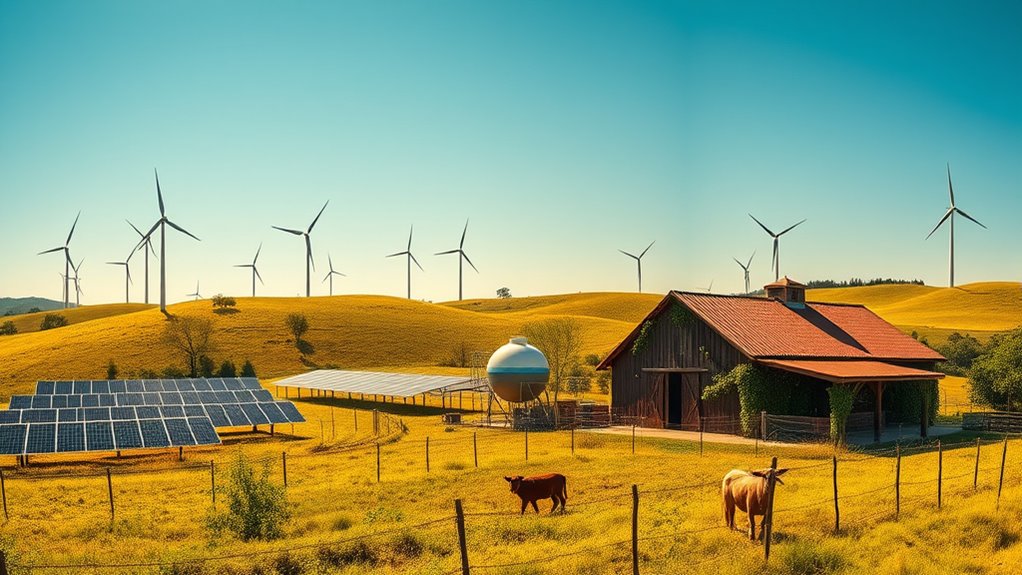
With the rapid evolution of technology, off-grid energy solutions are becoming increasingly efficient and accessible for farms. Innovations in solar energy, like advanced materials and smarter inverters, boost solar panel efficiency to 30-40% while lowering costs. Wisconsin imposes state income tax on IRA withdrawals, which highlights the importance of integrating energy efficiency with financial planning. Additionally, hydrogen fuel cells offer reliable, combustion-free operation, generating zero harmful emissions while providing a sustainable energy source for farm operations. Energy storage is also improving, with next-generation batteries ensuring you can use power when you need it. In wind energy, small-scale turbines adapt to varying conditions for consistent power generation. Bioenergy systems convert organic waste into usable energy, reducing emissions and diversifying your energy sources. Smart technologies like AI optimize performance and energy management. Additionally, plant-based sources like those found in chia seeds can support sustainable practices on farms by promoting soil health and biodiversity. These advancements empower you to harness renewable energy effectively, transforming your farm's sustainability and energy independence.
Frequently Asked Questions
What Is the Initial Cost of Setting up Off-Grid Renewable Energy Systems?
The initial cost for setting up off-grid renewable energy systems varies widely.
For solar panels, you might spend between $3,500 and $35,000, depending on efficiency. Charge controllers range from $140 to $500, while inverters can cost between $3,000 and $13,000.
Battery banks typically run from $2,000 to $16,000. Overall, you could be looking at a starting investment of around $1,917 for small systems, up to $150,000 for comprehensive setups.
How Do I Choose the Right Renewable Energy Source for My Farm?
When you're choosing the right renewable energy source for your farm, consider your specific energy needs, location, and budget.
Evaluate options like solar for sunny areas or wind if you have consistent breezes.
Think about the initial costs and potential savings.
Assess how each source integrates with your farming operations and their environmental impacts.
Finally, check for any government incentives that could help offset your investment.
What Maintenance Is Required for Off-Grid Renewable Energy Systems?
What good is a renewable energy system if it's not properly maintained?
For off-grid systems, you'll need regular checks on solar panels, inverters, and batteries to ensure optimal performance. Keep those panels clean and inspect for damage.
Wind turbines require lubrication and part checks, while hydro systems need careful water flow management.
Using monitoring tools can help you track everything easily, so you can address issues before they become bigger problems.
Can I Combine Multiple Renewable Energy Sources on My Farm?
Yes, you can combine multiple renewable energy sources on your farm!
Integrating solar panels with wind turbines, for instance, can offer a reliable energy supply throughout the day and night. You might also consider biofuels to complement your solar energy.
By diversifying your energy sources, you increase your independence and resilience while potentially lowering operational costs.
Just be aware of the initial investment and maintenance that comes with managing multiple systems.
What Are the Potential Grants Available for Renewable Energy Projects?
When it comes to grants for renewable energy projects, you've got plenty of fish in the sea!
You can check out federal programs like REAP, which offers funding for solar and wind projects. Many states provide specific grants tailored to local needs, too.
Don't forget nonprofit options like SARE. Just make sure you meet eligibility criteria, prepare your documents, and stick to deadlines.
With the right approach, you could secure valuable funding!
Conclusion
As you explore off-grid renewable energy options for your farm, you'll likely find that the right mix can lead to surprising benefits. Imagine harnessing solar, wind, and biomass together—it's a coincidence that they complement each other so well. You not only boost your energy independence but also create new economic opportunities. By embracing these technologies, you're not just powering your farm; you're paving the way for a sustainable future. It's a win-win that's hard to overlook!

